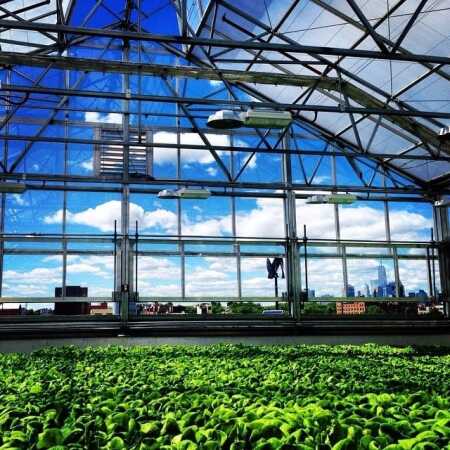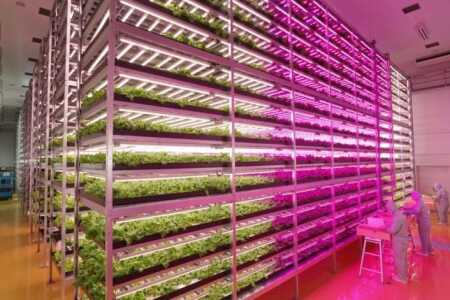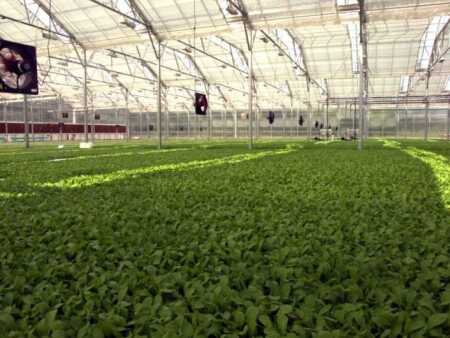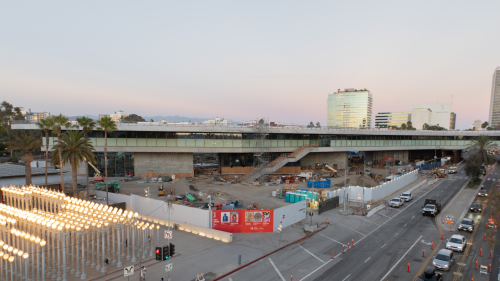As technology progresses and business models are refined, entrepreneurs around the world are exploring different ways to grow food in urban areas. Here are five of the most innovative urban farming projects currently in operation.
Related: Citiscope: Can urban agriculture work on a commercial scale? | ULI Tour: The Revitalization of Downtown Brooklyn
Brooklyn Grange, New York City, United States
Brooklyn Grange operates the world’s largest rooftop soil farm out of two buildings in the boroughs of Queens and Brooklyn, totaling 2.5 acres (1 ha). The farm grows more than 50,000 pounds (22,500 kg) of organically cultivated produce each year, and distributes it through farmers’ markets, community-supported agriculture networks, and wholesale to restaurants and catering companies. Because automotive pollutants are denser than air, the farm’s produce remains largely unaffected by city pollution.
Gotham Greens, New York City, United States
Gotham Greens’ two hydroponic rooftop farms in Brooklyn grow over 600,000 pounds (272,000 kg) of leafy greens and tomatoes each year according to organic principles, recycling all wastewater and using photovoltaic panels for electricity needs. Like Lufa Farms, Gotham Greens uses biological pest control to regulate insect populations and bacteria. Their second farm is located on top of a Whole Foods grocery store, which sells some of the produce grown in the greenhouses. A third farm in Queens should start operating later this year.
Mirai plant factory, Miyagi prefecture, Japan
Plant physiologist Shigeharu Shimamura and his plant farming company Mirai turned a former Sony factory located in an area badly affected by the 2011 tsunami into an indoor farm that can boast of producing 10,000 heads of lettuce per day. The farm uses hydroponic cultivation, as well as a light-emitting diode (LED) lighting system developed by General Electric for optimal plant growth and which uses 40 percent less power than fluorescent lights. Shimamura says that productivity is up 100-fold compared with that of a traditional farm.
Urban Organics, St. Paul, Minnesota, United States
A few urban farms have started experimenting with aquaponics, a method combining fish farming and hydroponics; St. Paul’s Urban Organics is one of them. The facility, located in a former brewery, grows organic-certified greens and vegetables by reusing the nutrient-rich water from their tilapia-raising tanks, which in turn gets cleaned by the plants. This closed-loop, symbiotic system is waste-free and requires only 2 percent of the amount of water used in traditional agriculture. Both fish and greens are sold in local grocery stores.
Bright Farms, New York City and various locations, United States
This New York–based business wants to minimize the environmental impacts of the food supply chain by growing produce closer to supermarkets. Bright Farms now operates seven greenhouses in various American cities, in which it grows produce using hydroponics in partnership with supermarket chains. A new 100,000-square-foot (9,300 sq m) greenhouse—the world’s largest urban greenhouse—will soon open in Washington, D.C., and should provide about 1 million pounds (450,000 kg) of produce each year for 30 Giant grocery stores.
Reprinted with permission by Citiscope. Citiscope is a nonprofit news outlet that covers innovations in cities around the world. More at Citiscope. org.








